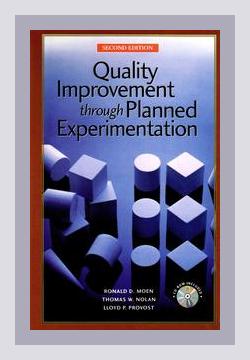Operations and Supply Chain ManagementQuality Control
Introduction:
The book “Quality Improvement Through Planned Experimentation,” written by Ronald D. Moen, Thomas W. Nolan, and Lloyd P. Provost, stands as a comprehensive guide on harnessing the power of structured experiments to enhance quality control in various settings. The 2012 edition builds on the principles of the Plan-Do-Study-Act (PDSA) cycle and offers a detailed approach to using statistical rigor in improving product and process quality. Utilizing myriad examples and procedures, the authors aim to impart the techniques necessary for practitioners to leverage data in making informed decisions.
Major Points and Actions
1. Introduction to Planned Experimentation
- Major Point: Planned experimentation is a methodical approach to understanding and improving processes.
- Action: Adopt a structured methodology for experimentation in your quality improvement processes.
- Example: In a manufacturing setup, engineers could use planned experiments to determine which combination of variables, such as temperature, pressure, and material type, yields the highest product quality.
2. Fundamentals of the Scientific Method
- Major Point: Applying the scientific method involves careful planning, execution, and analysis of experiments.
- Action: Use the scientific method in designing your experiments: define the problem, develop hypotheses, plan the experiment, collect and analyze data, and draw conclusions.
- Example: An automotive company might investigate whether a new type of steel affects the durability of car parts. They would hypothesize that the steel will increase longevity, conduct trials using the new steel, and analyze the results to make data-backed conclusions.
3. The Plan-Do-Study-Act (PDSA) Cycle
- Major Point: The PDSA cycle is foundational to quality improvement and involves iterative testing of changes.
- Action: Integrate the PDSA cycle into your continuous improvement initiatives.
- Example: A healthcare provider might use the PDSA cycle to improve patient wait times by first planning an intervention (Plan), implementing it on a small scale (Do), analyzing patient wait times (Study), and making necessary adjustments (Act).
4. Factorial Experiments
- Major Point: Factorial experiments examine multiple variables simultaneously to understand their effects.
- Action: Use factorial designs to assess the impact of multiple factors and their interactions.
- Example: A food processing company could conduct a factorial experiment to determine the optimal combination of ingredients and cooking processes that result in the best product quality.
5. Fractional Factorial Designs
- Major Point: Fractional factorial designs are efficient for studying a subset of possible combinations, reducing time and cost.
- Action: Apply fractional factorial designs when exploring numerous variables to maximize efficiency.
- Example: A pharmaceutical company might use fractional factorial designs to test combinations of drug formulations and dosing schedules while minimizing resource expenditure.
6. Response Surface Methodology
- Major Point: Response Surface Methodology (RSM) helps in optimizing processes by modeling and analyzing problems where several variables influence the outcome.
- Action: Employ RSM when seeking to optimize complex processes with multiple influencing factors.
- Example: In chemical engineering, RSM could be used to find the optimal conditions for a reaction that maximizes yield while minimizing waste.
7. Robust Design
- Major Point: Robust design focuses on improving products to be consistent under varying conditions.
- Action: Implement robust design principles to enhance product reliability and performance.
- Example: A consumer electronics company might employ robust design to ensure that their products function well under diverse environmental conditions, such as different temperatures and humidity levels.
8. Design of Experiments (DOE) with Multiple Responses
- Major Point: Experiments often have multiple responses or outputs that need to be analyzed together.
- Action: Consider the impacts on all relevant outputs when designing and analyzing experiments.
- Example: In a plastics manufacturing process, an experiment might examine the impact of temperature and pressure on both the strength and flexibility of the plastic, requiring simultaneous optimization of these responses.
9. Quality by Design (QbD)
- Major Point: Quality by Design (QbD) is a proactive approach that incorporates quality considerations into product design and development from the outset.
- Action: Use QbD principles to preemptively address potential quality issues during the design phase.
- Example: In drug development, QbD might involve designing an experiment that ensures the drug delivery system maintains its efficacy across various storage conditions.
10. Statistical Process Control (SPC)
- Major Point: SPC uses statistical methods to monitor and control processes, ensuring continuous improvement.
- Action: Implement SPC to maintain high standards of quality consistent with control charts and statistical analysis.
- Example: A beverage company could use SPC to monitor filling levels of bottles, identifying and correcting any deviations before product shipping.
Conclusion
“Quality Improvement Through Planned Experimentation” is a detailed and pragmatic guide designed to help practitioners implement effective quality control measures. By leveraging the scientific method, PDSA cycles, factorial experiments, and other statistically rigorous techniques, readers can achieve significant improvements in process efficiency and product quality. This structured approach not only aids in identifying optimal conditions for various processes but also fortifies products against variability, ensuring superior and consistent performance across different scenarios.
